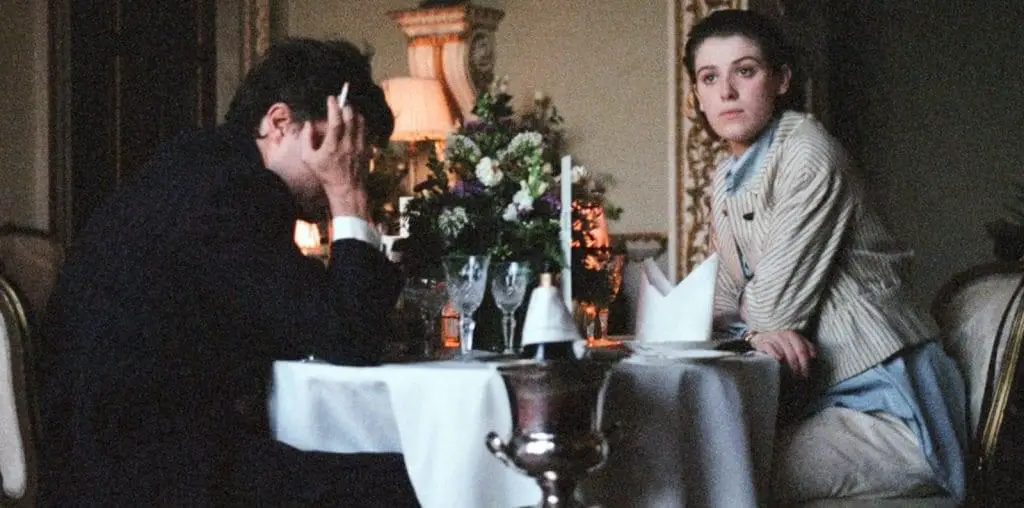
Lowave presents two recent films by Maurice Lemaître (both from 2002), a master experimental filmmaker for over 45 years. For those of you unfamiliar with Lemaître (even within experimental film circles, he is more well-known in Europe), his 1962 film/performance “Le film est déjà commencé?” was a radical, influential work which redefined almost every aspect of the cinematic event, from the use of the camera, to the projector, to the relationship to the audience. He is a key instigator of Lettrism.
Unfortunately, these two recent films are not particularly interesting to look at or to listen to. “Nos Stars,” which purports to elevate women within the avant-garde film world to the same status enjoyed by the great movie stars of the silent era, employs familiar experimental strategies on footage of the women: painting, scratching, refilming, and projecting film directly onto their faces and bodies. These effects do not create anything startlingly new or beautiful. Lemaître himself writes in his notes that the main interest of the film lies in his concept: to invite a variety of other (female) artists to make contributions to the film, thereby expanding the concept of authorship. It is true that, unlike movie stars of an earlier era, women here are shown wielding cameras and projectors, and they figure as creative artists, directly in control of the means of producing images. In this mostly silent film, the soundtrack at one point includes Lemaître’s original invitation to the women artists. Unfortunately, this invitation, as written, gives the (no doubt wholly undeserved) impression that the film is a scam whereby a desperate older man is trying to entice young women into revealing to him their sexual fantasies and experiences. For some reason, the producers at Lowave put the English subtitles for this film at a much slower rate than the text is spoken. To the degree that one believes there was an original artistic choice on the part of the artist to place certain words together with certain images (highly doubtful to begin with), this scheme is a subversion of his intentions.
“Le Petit Dieu” appears to be a 2002 reworking of a film from 1972.
(Lowave’s documentation is unclear and incomplete.) In the original version, the image consists of a completely abstract collage of flashes and slashes of light. The soundtrack consists of a woman’s voice reading a long allegorical fable, supposedly a children’s story, about a young god and his philosophical musing conversation with his parents about the differences between trains and apples. The story appears to have an underlying theme of the differences between male and female, artificial and organic, and of their underlying unity. In the updated version, the same text is presented in written form, on top of the original footage. The spoken version of the text is in French, but the written form (which does not correspond in time to the spoken voice) is in English. Lemaître experiments with a variety of simple motion graphic techniques to illustrate the story: the use of different fonts, different text colors, and different kinds of simple motion for the text. Unfortunately, in this day in which commercial film and television has developed the art of motion graphics so extensively (if in a banal and exploitative direction), Lemaître shows himself to have no particular skill in this art. His graphic choices most often show a literal interpretation of the text, adding little or nothing to the story. They are also not skillfully executed. The flashing lights from the 1972 footage add little to the overall experience. Vague, overly intellectual story plus bad motion graphics equals uninteresting film.
Watching this DVD reminded my of my experience seeing older and newer films by Kenneth Anger at a recent screening, the “Views from the Avant-Garde” section of the New York Film Festival. Anger’s films from the 40s, 50s and 60s, such as “Fireworks” and “Rabbit Moon,” newly restored to gorgeous 35mm prints, are enduring masterpieces which never cease to thrill me. His most recent work, however, a video which celebrates Disney kitsch, although it pleased many in the audience, struck me as puerile and formless. Likewise, I ended up feeling that although Lemaître is a very important filmmaker, interested viewers would do better to try and read about or find screenings of his seminal works from the 60s, rather than buying this DVD.
